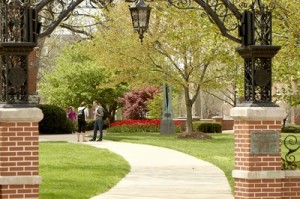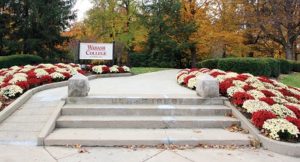DePauw University is a private liberal arts college settled in Greencastle Indiana, with a total enrollment of more than 2,300 students. 45 miles away from Indianapolis, it is a serene setting with an on campus nature park. This university has an acceptance rate of just over 60 percent.
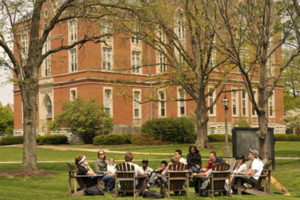
DePauw University
Wabash College, also in Indiana, and having a similar acceptance rate of more than 60 percent, enrolls a total of only 900 all-male students to a campus in Crawfordsville. Wabash ranks in the top five on our Most Satisfied Students list for liberal arts colleges, and with a school like DePauw “right down the street,” distinctions like this do not come easy. Students at DePauw are more likely to pay for their own education than those at Wabash, with need based aid reaching only about 50 percent of DePauw students; at Wabash, the figure is 90 percent.
These two schools draw on the same caliber of students for their enrollment, have a similar geographic setting. Our survey took aim to see what differences there were under the surface, and on the campus!
Academics
As with most small, private, liberal arts colleges, the students at both DePauw University and Wabash College face a challenging workload. According to our survey, students at Wabash were more challenged than those at DePauw, with 65 percent responding that the workload “consumed most of their time” and was “difficult.” At DePauw, the response for a “difficult” workload was 52 percent.
However, when asked how many hours a day students actually spent studying, the response was nearly identical at both schools: the clear majority, 60 percent of students at both schools, responded that they would study 3 to 4 hours a day. The distinction here is not massive, but when we asked about the academic environment, an important difference was uncovered.
Wabash College students responded strongly (50 percent) that the academic environment at their school was “highly competitive.” This marked a clear difference between the two schools: only 15 percent of DePauw students felt the environment was “highly competitive.” Our survey found that the rest of DePauw students were evenly divided between those who felt the academic environment was simply “competitive,” and those feeling it was “collaborative.” There is a clear difference between the academic environments of both schools that prospective students would do well to consider.
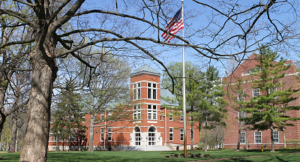
Wabash College
Faculty
The relationship between students and faculty at DePauw was one of the highlights that students took the time to mention in our survey. A DePauw sophomore said, “The best thing about DePauw are the professors. They are all genuine, brilliant people who always go out of their way to help you in any way they can, while still challenging you academically.” 45 percent of DePauw students responded that they spoke with professors about classroom topics outside of class monthly and 45 percent did so weekly.
Even so, 65 percent of Wabash students spoke to professors outside of class weekly. This is a distinct advantage for Wabash students in an area that DePauw students felt strongly about. A Wabash sophomore said, “I have a rigorous course load, my classroom experience is one of the best in the nation, my professors are always available, and the traditions of my school are extremely unique. I’ve never heard of another school that has traditions like them, and I have ample opportunities to socialize.” The “unique” tradition at Wabash is one of the aspects of college life we will consider next in our analysis.
Campus Life
A special attribute that Wabash College holds, that very few other schools can claim, is that Wabash is an all male college. This leads to the fact that 55 percent of Wabash students feel a “very strong” sense of community where less than 20 percent feel such kinship at DePauw.
“The academic community that challenges and tests its students and the campus community that unites the Wabash brotherhood” is what a Wabash sophomore found distinctive about his school. Indeed, this was an outstanding aspect in the survey results. The students at Wabash, as we have seen, face an uphill climb in academic areas, and this helps create a bond that is enduring among its students.
Housing is always a factor in terms of student satisfaction with campus life, and both schools showed nearly identical responses to questions about housing on campus. 55 percent of those surveyed at both colleges were “very satisfied” with their housing.
A DePauw sophomore said, “I love that students are required to live on campus all four years, so housing is guaranteed. But there are still plenty of different options for living situations.” For DePauw students this includes fraternities and sororities, which seem to be a large part of social life on campus. One DePauw sophomore went as far as to say, “The Greek system dominates the school entirely.”
When a school is dominated by a Greek system, there is frequently an inverse relationship with the amount of interaction students have with the local community. In this instance, 55 percent of Wabash students surveyed were willing to say that there was “frequent interaction” with their local community. About the same percentage said that community relations were only “somewhat close” between DePauw and its surrounding community. This last fact leads us to understand still more about DePauw when we look at the social life on that campus.
Social Scene
According to our survey, nearly 80 percent of those asked at DePauw said that social life was centered “mostly on campus,” and this is in line with the fact mentioned above, that DePauw did not have much interaction with the surrounding community. There was more balance to the Wabash responses for this question, but still, less than 20 percent felt that there was an even balance between on and off campus activities.
As far as on campus activities go, 75 percent of DePauw students said that “many” or “most people” go to campus-sponsored activities. At Wabash, nearly 90 percent felt that same way, which tells us that Wabash’s sense of community translates into its social life as well.
Social life is clearly centered on campus for DePauw students, but fewer attend college sponsored activities. Rather, more than 45 percent of those surveyed said that there were social cliques on campus and that they “play a big part” in the college social life there. Wabash students were far more likely, more than 50 percent, to say that social cliques exist, but “do not play a big part in campus life.”
55 percent of Wabash students admitted that drinking and alcohol were “part of most activities.” In addition, 20 percent of students at both schools felt that drinking was “vital” to the campus social life experience.
Indeed, a DePauw sophomore said, “The presence of alcohol on campus is a big problem, and one that does not go unnoticed. If it were up to me, I would try to bring in more activities for students to do on the weekends. Even though I myself am Greek, I think advocating the independent lifestyle would help reduce the role that alcohol has in every weekend.”
The social lives at these two schools have clear differences, and it is up to the prospective students to decide what kind of experience they’d like for the next four years.

DePauw University
Conclusion
While clearly being in a more competitive academic atmosphere, 70 percent of Wabash students were still “very satisfied” with their college experiences. Wabash College attracts a specific kind of student, and as we have seen in our analysis it pays great dividends. Its top five ranking in Student Satisfaction is well earned: Wabash combines a competitive academic environment with a balanced social environment, creating a memorable college experience. Said a Wabash sophomore, “If you want a great education and to build brotherly bonds, this is the place for you.”
Despite being somewhat cliquish and isolated, DePauw students had positive things to say about their school as well: “I love this school and especially my liberal arts education. It has allowed me to get involved and meet some people that I would have never imagined I would meet at a larger, public school,” said a DePauw senior.
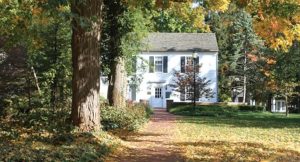
Wabash College
In conclusion, students at both schools would definitely recommend their school to others, though there are unique distinctions that make the experiences at these two colleges very different ones indeed.
